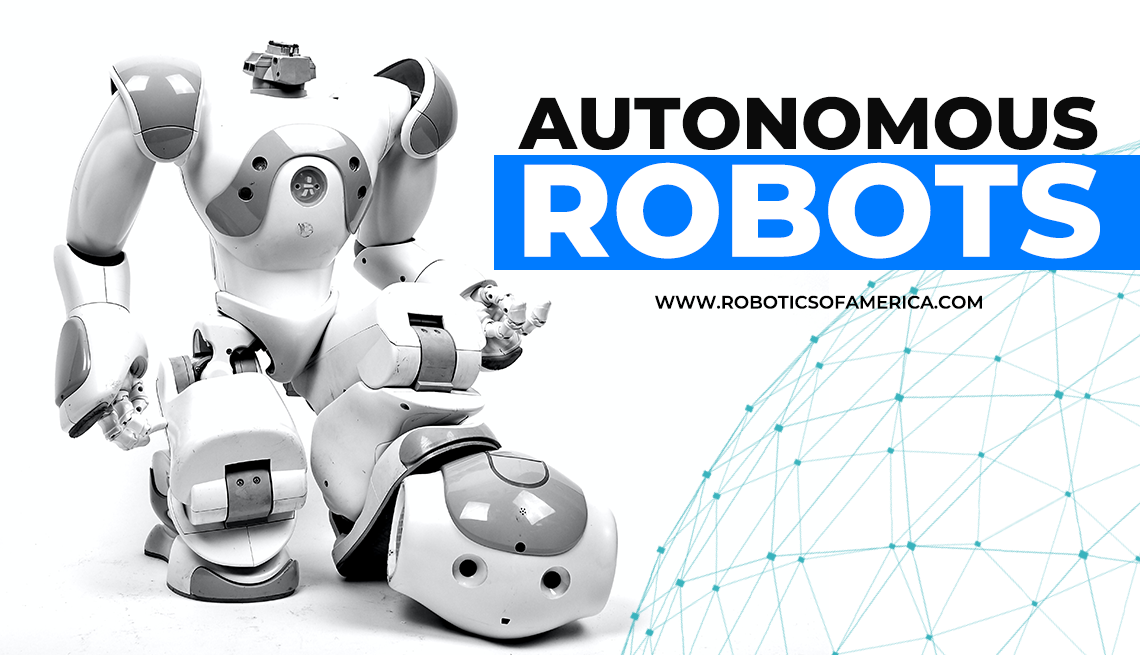
AI in Robotics
An Introduction to Autonomous Robots
Autonomous robots are becoming more commonplace as technology evolves. But what are autonomous robots? Why do they exist? And how can they help companies make money? This article will answer these robotics-related questions. Are you ready? Let’s get started.
So, What Is an Autonomous Robot?
Before we examine autonomous robots, let’s start out by examining autonomy itself. It is the process by which people (or robots) make decisions. Autonomy is the driving force behind humans doing actions of all kinds. Without autonomous capabilities, we wound not be able to even talk and walk.
Now that you know what autonomy is, you're prepared to understand the autonomous robot. It is a robot that, well, can make decisions. But making decisions is only part of the process. Autonomous robots can also act on their decisions. This is how humans get tasks done. And now, thanks to technology advancing, robots can complete plenty of tasks.
The modern autonomous robot is able to have unique perceptions about its environment. After processing the perceptions, the robot makes a decision. That decision takes the perceptions into account. Or, the robot's programmed to manipulate an environment based on recognition-abilities. Below are some examples of actions that autonomous robots can take. All these actions stem form the decision-making process:
- -starting a physical action
- -pausing a physical action
- -stopping a physical action
- -moving past obstacles that are in the way
Roomba: An Example of an Autonomous Robot
Sure, the concept of an “autonomous robot” sounds futuristic. But it’s likely that you've seen autonomous robots in the past. Roomba is a great example. What is Roomba? It’s one of those robotic vacuum cleaners that can move around on its own.
What makes Roomba autonomous? It can make decisions and take unique actions. Those actions get determined by the perception of Roomba’s environment. In fact, the decision-making process is what inspires people to buy Roombas. You can turn Roomba on and it will patrol a house, vacuuming on its own. No human operator or power cord's required. That lack of needed supervision is another factor that makes Roomba autonomous.
Roombas get constructed with sets of sensors. The sensors are what enable each Roomba to process surrounding environments. It takes action once it has evaluated what the sensors displayed. Here is an example. Say Roomba encounters a couch. It is capable of deciding whether to ignore the couch or move around the couch. In other words, it has an autonomous sense of changing direction.
Here is another example. Each Roomba has a built-in dirt detector. The Roomba uses autonomous processing to interpret how much dirt is on the floor. It uses that information to determine how long it should clean the dirt. The Roomba is more than a vacuum cleaner. It is an example of how autonomous robots are starting to benefit people.
The 4 Most Common Types of Autonomous Robots
Roomba is not the only popular autonomous robot. The most common autonomous robots are getting used by companies across the world. Let’s go over these top-rated robots.
1) Autonomous robots that do goods-to-person picking.
Autonomous robots are changing the landscape for manufacturing and logistics companies. These organizations used to have to rely on paper or manual picking systems. But robots can now speed up the picking processes.
Advancements in three factors have led to autonomous robots excelling at goods-to-person picking. 1. Mobility. 2. Artificial intelligence. 3. Advanced sensors. These three factors allow companies to place their robots in almost any location. In fact, you might want to research the following three companies some time. 1. Bleium. 2. GreyOrange. 3. IAM Robotics. What do these three organizations have in common? They have started using autonomous robots. And it has led to boosted ROI and profits.
Autonomous robots often transport carts while participating in the picking process. Operators can program the robots to move across certain areas. The average autonomous picker moves goods between stations and staff members. The robots can move a lot faster than humans without getting tired. This has sped up the picking process by dozens of percentage points.
2) Self-driving autonomous robots.
Yes, robots now have the ability to drive on their own. But this concept applies to more factors than cars and trucks. Let’s use forklifts as an example. For decades, forklifts were simple and required a human to move them. Not anymore. The modern forklift is getting equipped with 100% autonomous, robotic features. That’s right- forklifts are becoming intelligent.
Increased intelligence has led to modern forklifts having more uses than before. They are now able to do more operations than regular forklifts. This is due to advanced load-handling processes. Forklifts can now move faster, lift more goods, and recognize potential dangers. Many autonomous forklifts even feature navigation lasers and scanners. Their 3D cameras ensure that they get warned well before accidents can occur. This protects a company’s human workers from getting injured. The autonomous robot-forklift detects objects that are in the way and in real-time. It then makes adjustments and continues the mission. Whether your company transports trailers or pallets, an autonomous robot speeds up processes.
Let’s use the ZF Innovator Forklift as an example. It’s a new, autonomous-robotic forklift featuring incredible technology. It has advanced driving systems with unheard levels of speed. It even has its own radar to check out its surroundings. This forklift knows where goods are at all times. It then makes calculations to pick up and deliver the goods in record time. And get this. The ZF Innovator Forklift is self-aware of its battery percentage. Say the percentage is low. The robotic forklift travels back to its charging station and juices up.
3) Autonomous robots that conduct inventory monitoring.
More and more autonomous robots are getting designed with inventory monitoring intelligence. These robots can now do inventory sweeps faster than humans can. But they are not stubborn. The robots do the sweeps based on the schedule that the specific company puts in place. This is perfect for organizations that have RFID-tagged products.
Most organizations conduct inventory counts every few months. Of course, that schedule can lead to a lot of problems. But now, inventory counts can occur many times every day. This is getting companies organized like never before. After all, real-time data is a company’s secret weapon. And these robots share that data with employees on a 24/7 basis.
Many autonomous robots in this sector get equipped with RFID interrogators. The provide continuous coverage for detecting products. In fact, many autonomous robots can recognize products from 25 feet away. This does more than boost manual inventory counts. It provides supervisors with advanced, real-time mapping. This improves the product storage abilities of any organization. Say the autonomous robot realizes that there is a storage or placement problem. The robot then alerts the supervisor so changes can take place.
Some RFID robots are on the market for $50,000 each. Sure, that’s a lot of cash. But studies have proven the average customer saves money in the long-run. In fact, many companies have reported that the robots save them over $1,000,000 per year. That figure applies to factors like labor reduction, waste reduction, and inventory improvements. A robot might be the smartest $50,000 that your company has ever spent.
4) Autonomous Robots in Unmanned Aerial Vehicles.
You might start to recognize a recurring concept about autonomous robots. And that is that many of them specialize in transportation. Aerial vehicles are no exception. Lightweight unmanned autonomous vehicles are becoming more popular by the year. These are often referred to as UAVs. Each UAV robot features RFID scanning technology. Once again, this is to asses the inventory of all sorts of organizations.
But not all UAVs are only good for scanning merchandise. Your average UAV robot has aerial capabilities. It can deploy across the skies on all sorts of unique missions. Operators from the ground assist the UAV robots. They help them make scans, deliver goods, and do many other activities. Advanced sensors ensure that these autonomous robots never hit other objects.
Companies use cloud technology to upload new processes into their UAVs. Synchronization then occurs so that the robots are always up-to-date. These robots are so intelligent that they can adapt to ideal flight patterns on their own. Once again, this gives companies the speed to get tasks done fast.
Conclusion: Autonomous Robots Are Taking Companies to New Heights
Autonomous robots provide companies with an endless number of benefits. Cost-reduction. Faster processes. Improved worker safety. Boosted ROI and profit margins. The list goes on and on. This article would be millions of words long if we listed all the benefits. That’s why you should check out more robot content on our website. We offer plenty of information about topics like these:
- -types of autonomous robots
- -autonomous robots in manufacturing
- -names of autonomous robots
- -an autonomous robots PDF
- -examples of autonomous robots
- -examples of semi-autonomous robots
- -an autonomous robots journal
- -find out more about what autonomous robots are used for
- -how to make money by using an autonomous robot

